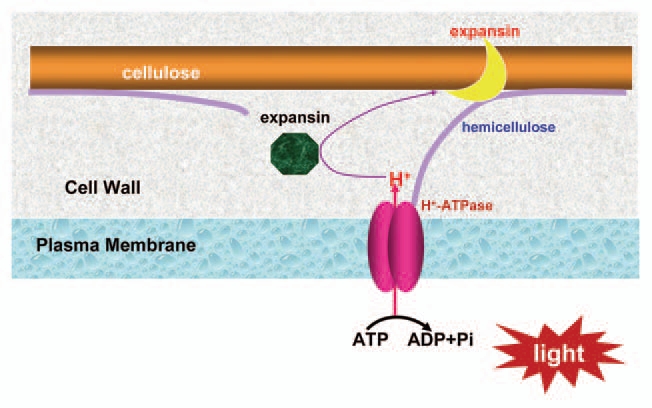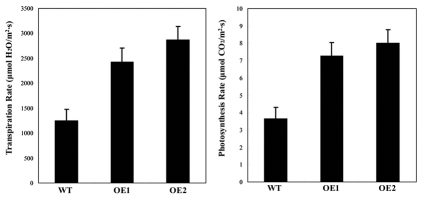Abstract
Stomatal movement is strictly regulated by various intracellular and extracellular factors in response environmental signals. In our recent study, we found that an Arabidopsis guard cell expressed expansin, AtEXPA1, regulates stomatal opening by altering the structure of the guard cell wall. This addendum proposes a mechanism by which guard cell expansins regulate stomatal movement.
Key words: expansin, stomatal movement, AtEXPA1, guard cell, wall loosening
Stomatal movement is the most popular model system for cellular signaling transduction research. A complicated complex containing many proteins has been proposed to control stomatal responses to outside stimuli. The known regulation factors are primarily located in the nucleus, cytoplasm, plasma membrane and other intracellular organelles.1,2 Although the cell wall structure of the stomata is different from that of other cells,3,4 the presence of stomatal movement regulation factors in the cell wall has seldom been reported in reference 5. In our previous work, we found that extracellular calmodulin stimulates a cascade of intracellular signaling events to regulate stomatal movement.6 The involvement of this signaling pathway is the first evidence that cell wall proteins play an important role in regulation of stomatal opening. Cell wall-modifying factors constitute a major portion of cell wall proteins. However, the role of these factors in the regulation of stomatal movement is not yet known.
Expansins are nonenzymatic proteins that participate in cell wall loosening.7–9 Expansins were first identified as “acid-growth” factors because they have much higher activities at acidic pHs.10,11 It has been reported that expansins play important roles in plant cell growth, fruit softening, root hair emergence and other developmental processes in which cell wall loosening is involved.7–9,12,13 Wall loosening is an essential step in guard cell swelling and the role of stomatal expansins was investigated. AtEXPA1 is an Arabidopsis guard-cell-specific expansin.13,14 Over-expressing AtEXPA1 increases the rate of light-induced stomatal opening,14,15 while a potential inhibitor of expansin activity, AtEXPA1 antibody, reduces the sensitivity of stomata to stimuli.14 We showed that the transpiration rate and the photosynthesis rate in plant lines overexpressing AtEXPA1 were nearly two times the rates for wild-type plants (Fig. 1). These in plant data revealed that expansins accelerated stomatal opening under normal physiological conditions. In addition, the increases in the transpiration and photosynthesis rates strongly suggested the possibility of exploiting expansin-regulated stomatal sensitivity to modify plant drought tolerance. Compared with the effect of hydrolytic cell wall enzymes, the destruction of cell wall structures induced by expansins is minimal. In addition, it is very difficult to directly observe the changes in the guard cell wall structure caused by expansins during stomatal movement. Our recent work showed that, in AtEXPA1-overexpressing plants, the volumetric elastic modulus is lower than in wild-type plants,14 which indicates the wall structure was loosened and that the cell wall was easier to extend. Taken together, our data suggest that expansins participate in the regulation of stomatal movement by modifying the cell walls of guard cells.
Figure 1.
Effects of AtEXPA1 overexpression on transpiration rates and photosynthesis rates. The transpiration rate (left) and photosynthesis rate (right) of wild-type and transgenic AtEXPA1 lines were measured at 10:00 AM in the greenhouse after being watered overnight. The illumination intensity was 180 µmol/m2·s. Bars represent the standard error of the mean of at least five plants per line.
It is well known that the activation of proton-pumping ATPase (H+-ATPase) in the plasma membrane is an early and essential step in stomatal opening.16 The action of the pump results in an accumulation of H+ outside of the cell, increases the inside-negative electrical potential across the plasma membrane and drives potassium uptake through the voltage-gated, inward-rectifying K+ channels.17–19 The main function of the H+ pump is well accepted to create an electrochemical gradient across the plasma membrane; however, the other result is the acidification of the guard cell wall, which may also contribute to stomatal opening. A possible mechanism responsible for this effect is as follows. Expansins are in an inactive state when the stomata are in the resting state. Stomatal opening signals induce wall acidification and activate expansins. Then, the expansins move along with cellulose microfibrils and transiently break down hydrogen bonding between hemicellulose and the surface of cellulose microfibrils,20,21 facilitating the slippage of cell wall polymers under increasing guard cell turgor pressure. The guard cell then swells and the stomata open (Fig. 2).
Figure 2.

Model of how guard cell wall expansins regulate stomatal opening. Environmental stimuli, e.g., light, activate guard cell plasma membrane H+-ATPases to pump H+ into the extracellular wall space. The accumulation H+ acidifies the cell wall and induces the activation of expansin. The active expansin disrupts non-covalent bonding between cellulose microfibrils and matrix glucans to enable the slippage of the cell wall. The wall is loosened coincident with guard cell swelling and without substantial breakdown of the structure.
Although our results indicate that AtEXPA1 regulates stomatal movement, the biochemical and structural mechanism by which AtEXPA1 loosens the cell wall remains to be discovered. It remains to figure out the existing of other expansins or coordinators involving in this process. In addition, determining the roles of expansins and the guard cell wall in stomatal closing is another main goal of future research.
References
- 1.Cutler SR, Rodriguez PL, Finkelstein RR, Abrams SR. Abscisic acid: Emergence of a core signaling network. Annu Rev Plant Biol. 2010;61:651–679. doi: 10.1146/annurev-arplant-042809-112122. [DOI] [PubMed] [Google Scholar]
- 2.Schroeder JI, Allen GJ, Hugouvieux V, Kwak JM, Waner D. Guard cell signal transduction. Annu Rev Plant Physiol Plant Molec Biol. 2001;52:627–658. doi: 10.1146/annurev.arplant.52.1.627. [DOI] [PubMed] [Google Scholar]
- 3.Franks PJ, Buckley TN, Shope JC, Mott KA. Guard cell volume and pressure measured concurrently by confocal microscopy and the cell pressure probe. Plant Physiol. 2001;125:1577–1584. doi: 10.1104/pp.125.4.1577. [DOI] [PMC free article] [PubMed] [Google Scholar]
- 4.Raschke K, Dickerson M. Changes in shape and volume of guard cells during stomatal movement. Plant Res. 1973;1972:149–153. [Google Scholar]
- 5.Jones L, Milne JL, Ashford D, McQueen-Mason SJ. Cell wall arabinan is essential for guard cell function. Proc Natl Acad Sci USA. 2003;100:11783–11788. doi: 10.1073/pnas.1832434100. [DOI] [PMC free article] [PubMed] [Google Scholar]
- 6.Chen YL, Huang R, Xiao YM, Lu P, Chen J, Wang XC. Extracellular calmodulin-induced stomatal closure is mediated by heterotrimeric G protein and H2O2. Plant Physiol. 2004;136:4096–4103. doi: 10.1104/pp.104.047837. [DOI] [PMC free article] [PubMed] [Google Scholar]
- 7.Sampedro J, Cosgrove DJ. The expansin superfamily. Genome Biol. 2005;6:242. doi: 10.1186/gb-2005-6-12-242. [DOI] [PMC free article] [PubMed] [Google Scholar]
- 8.Li Y, Jones L, McQueen-Mason S. Expansins and cell growth. Curr Opin Plant Biol. 2003;6:603–610. doi: 10.1016/j.pbi.2003.09.003. [DOI] [PubMed] [Google Scholar]
- 9.Cosgrove DJ, Li LC, Cho HT, Hoffmann-Benning S, Moore RC, Blecker D. The growing world of expansins. Plant Cell Physiol. 2002;43:1436–1444. doi: 10.1093/pcp/pcf180. [DOI] [PubMed] [Google Scholar]
- 10.Cosgrove DJ. Loosening of plant cell walls by expansins. Nature. 2000;407:321–326. doi: 10.1038/35030000. [DOI] [PubMed] [Google Scholar]
- 11.Cosgrove DJ. Enzymes and other agents that enhance cell wall extensibility. Annu Rev Plant Physiol Plant Molec Biol. 1999;50:391–417. doi: 10.1146/annurev.arplant.50.1.391. [DOI] [PubMed] [Google Scholar]
- 12.Lee Y, Choi D, Kende H. Expansins: Ever-expanding numbers and functions. Curr Opin Plant Biol. 2001;4:527–532. doi: 10.1016/s1369-5266(00)00211-9. [DOI] [PubMed] [Google Scholar]
- 13.Cosgrove DJ. New genes and new biological roles for expansins. Curr Opin Plant Biol. 2000;3:73–78. doi: 10.1016/s1369-5266(99)00039-4. [DOI] [PubMed] [Google Scholar]
- 14.Zhang XQ, Wei PC, Xiong YM, Yang Y, Chen J, Wang XC. Overexpression of the Arabidopsis α-expansin gene, atexpa1, accelerates stomatal opening by decreasing the volumetric elastic modulus. Plant Cell Rep. 2010;30:27–36. doi: 10.1007/s00299-010-0937-2. [DOI] [PubMed] [Google Scholar]
- 15.Zhao P, Chen S, Wang XC. Arabidopsis expansin atexp1 involved in the regulation of stomatal movement. Acta Agron Sinica. 2007;32:562–567. [Google Scholar]
- 16.Edwards MC, Smith GN, Bowling DJF. Guard cells extrude protons prior to stomatal opening—a study using fluorescence microscopy and ph micro-electrodes. J Exp Bot. 1988;39:1541–1547. [Google Scholar]
- 17.Cho HT, Kende H. Expansins in deepwater rice internodes. Plant Physiol. 1997;113:1137–1143. doi: 10.1104/pp.113.4.1137. [DOI] [PMC free article] [PubMed] [Google Scholar]
- 18.Assmann SM. Signal transduction in guard cells. Annu Rev Cell Biol. 1993;9:345–375. doi: 10.1146/annurev.cb.09.110193.002021. [DOI] [PubMed] [Google Scholar]
- 19.Hedrich R, Schroeder JI. The physiology of ion channels and electrogenic pumps in higher plants. Annu Rev Plant Physiol Plant Molec Biol. 1989;40:539–569. [Google Scholar]
- 20.McQueen-Mason SJ, Cosgrove DJ. Expansin mode of action on cell walls (analysis of wall hydrolysis, stress relaxation and binding) Plant Physiol. 1995;107:87–100. doi: 10.1104/pp.107.1.87. [DOI] [PMC free article] [PubMed] [Google Scholar]
- 21.McQueen-Mason S, Cosgrove DJ. Disruption of hydrogen bonding between plant cell wall polymers by proteins that induce wall extension. Proc Natl Acad Sci USA. 1994;91:6574–6578. doi: 10.1073/pnas.91.14.6574. [DOI] [PMC free article] [PubMed] [Google Scholar]



